Total posts:
187
11/29/2010
On Monday last week I visited National Museums and Galleries Wales in Cardiff. With me I took two items I have mentioned previously on my blog the Iron Age bracelet/torc fragment (DUR-F3F8C4) and the Medieval mace head (DUR-5ACBE0).
I was meeting Mary Davies (Archaeological Conservator) and Adam Gwilt (Curator of Later Prehistory). They had both kindly agreed to give up some of their time to help me find out more about these two very interesting items. The museum in Cardiff has a great library and good scientific facilities for testing small finds, both of which are extremely useful when researching slightly unusual or rare objects.
Mary first put both items into the XRF machine (this stands for X-ray Flouresence and works by shooting X-rays at the item, depending on the chemical make-up of the object, a different spectrum is bounced back at the sensor). This was a portable XRF and so was quick and easy, it connected straight to a laptop and so allowed us to get easy to read graphs straight away. This method is qualitative only as it does not give exact amounts of each element but it does show the general proportions, i.e. in a copper alloy object the vast majority of the metal will be copper with small additions of tin, zinc, lead or other elements.
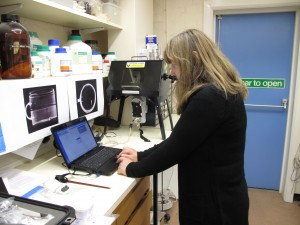
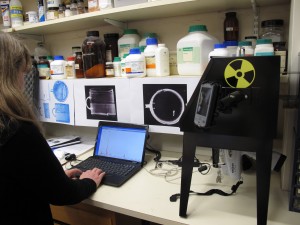
Next we went over the Archaeology Department at the University where they have an SEM machine. This is a special type of microscope, (a Scanning Electron Microscope), which means we can look at a tiny sample of an object at extremely high magnification. Electrons are shot at the sample and those which bounce back are again measured by the sensor and we can tell how much of each element is present (it is quantitative). Again the handy programme allowed us to get a graph of the elements and a table with the numbers.
Unfortunately the graphs and tables are stored in an excel file and I can;t get them onto my blog- however I will summarise the results below.
The Iron Age bracelet- was around 93% copper with c.6% tin with traces of lead, antimony and arsenic. This makes it a bronze and is a not unexpected alloy for this period.
The Medieval mace head- was around 83% copper, 8% tin and 5% lead with traces of other elements. The reason we tested this item was to help with the debate over whether these are Medieval or Bronze Age. Different alloys were used in different periods and so getting these items tested adds another element to our understanding of them. Unfortunately this alloy is not a typical Medieval alloy, although Mary did say it was more like Medieval alloys than Bronze Age so at least we have some tentative proof! The way forward with these items is to get more tested as it may turn out they were made with similar alloys (as I showed with my Wirral brooches, and others have shown with testing of other artefact types).
11/23/2010
November 23rd, 2010 by Ian Richardson
Today marked the launch of the official Treasure Annual Report 2008, listing all of the cases of Treasure reported between 1 January and 31 December 2008. Astute observers will note the vast difference in appearance and content between this and recent reports; absent are colour photographs and detailed description of select cases, and the report does not include items reported to the PAS that were not considered under the Treasure Act. Legislation does not allow for a combined Portable Antiquities &Treasure Annual Report to be officially laid before Parliament and so the 2008 incarnation of that report (which is forthcoming) will have to be launched separately. Under the circumstances, it was decided to produce the concise report launched today as an interim measure.
This short document is, however, by no means something to be overlooked. Since 2005/2006, we have endeavoured to ensure that a PAS Database record has been created for each find of reported Treasure, and those associated reference numbers have appeared alongside the Treasure case numbers in those reports. In the Treasure Report 2008, one can likewise refer to the database numbers for all of the listed cases. Similarly, with the new database, Dan Pett has created a separate field for Treasure case numbers, so it is possible to search for cases with only this information to hand.
On the www.finds.org.uk site, if one clicks on the ‘Database’ tab at the top of the page, and then clicks on ‘Search database’ tab at the left, a cascading menu allows for the choice of ‘Advanced Search’. Following that link will allow for the user to tick a box labelled ‘Treasure find:’ and to input a ‘Treasure ID number’. If one inputs, for example, the number ‘2008 T200’, a database entry for that case (an Early Medieval hooked tag) is returned.
The Finds Liaison Officers, Treasure Team, and several hard working volunteers have worked to update these records as thoroughly as possible with photographs, disposition information, and 4-figure findspot information. They have also ‘promoted’ as many of these records as possible to ensure that members of the public,and not just academics, have easy access to this information. The functionality built into the website, enabling reports to be printed, photos to be zoomed in on, and information to be sorted according to a variety of criteria, means that the presentation of the Treasure report in this format is useful and adaptable.
I’d like to congratulate my colleagues on the Treasure Team, Caroline Barton, Caroline Lyons, Hilary Orange and Janina Parol on the launch of this report; to extend hearty thanks to our volunteers Siorna McFarlane and Emma Traherne and the FLOs for their untiring work on these database records, and thank Dan Pett for designing such a comprehensive and easy-to-use interface. To my mind, the integration of the database with the Treasure records proves further the degree to which the work of the PAS is crucial to the successful administration of the Treasure Act. Today’s news, that the BM will assume authority of the PAS, seems a natural transformation that will hopefully ensure the Scheme’s continued success and even greater collaboration in the administration of Treasure cases. Lastly, congratulations to Michael Lewis, the editor of this report and the forthcoming combined report, for all his work in ensuring these documents come to fruition.
11/23/2010
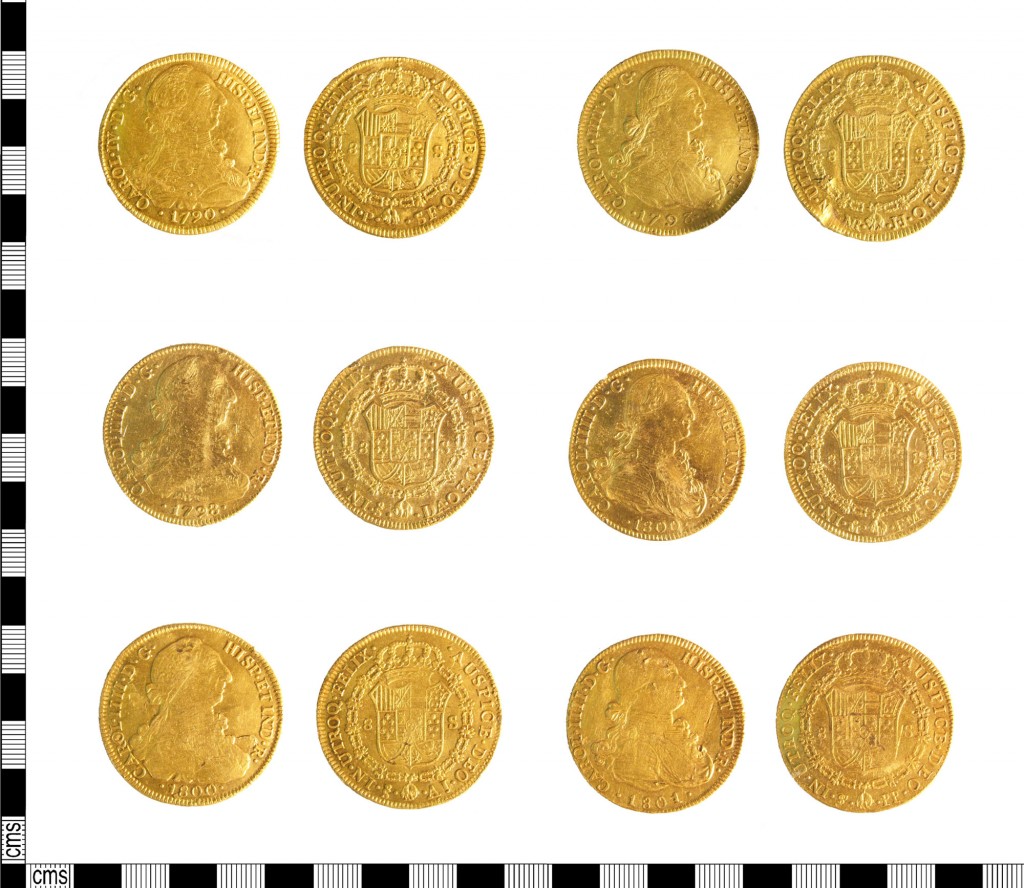
Spanish-American doubloons
Today (23.11.10) a hoard of gold Spanish-American ‘doubloons’ found near Lincoln were declared treasure by the Assistant Coroner for West Lincolnshire . The hoard comprises six gold coins of Charles IV of Spain dating between 1790 and 1801. The coins were minted at various locations across Spanish-America, including Chile, Bolivia and Mexico.
This was the time of the Revolutionary and Napoleonic wars, when gold coin was being carefully hoarded in England. Coin hoards are relatively rare after the time of the English Civil War, but the decades of the 1790s and 1800s are exceptions, especially with regard to gold. There are a significant number of such gold hoards on this scale, from between about 1794 to 1808, of from 8 to 57 gold coins. Spanish-American gold of this period was made to a standard of 88% fine gold.
The coins were discovered on the same site as a previous hoard of similar coins found in 1928. At the time of deposit, the value of the two groups of Lincoln coins, now numbering 24, would have equated to several thousand pounds in terms of modern-day purchasing power.
This particular hoard is unsual because despite being less than 300 years old it still falls under the provisions of the Treasure Act (1996). This is because it would previously have qualified as ”treasure trove’. Page 8, Para. 9 of the ‘Treasure Act (1996) Code of Practice’ state that:
‘Only objects that are less than 300 years old, that are made substantially of gold or silver, that have been deliberately hidden with the intention of recovery and whose owners or heirs are unknown will come into this catagory. In practice such finds are rare and the only such discoveries that have been made within recent years have been hoards of gold or silver coins of the eighteenth, nineteenth ot twentieth centuries.’
11/09/2010
The metal work from the hoard have begun to be assessed in the lab at the Colchester & Ipswich Museum Resource Centre. Each individual piece has been weighed and measured, and given a unique catalogue number.
The cataloguing of the hoard material is an ongoing process, with each piece of metal work assessed and identified, for example using the decoration on the axes to attribute it to a particular type.
Several of the complete axes contained soil in their sockets, and the contents had to be carefully removed looking for any metal work or organic matter that may have been deliberately stuffed into the socket opening. The position and selection of broken pieces of metalwork contained within the sockets may give us an insight into the selection process of somebody in the Bronze Age.
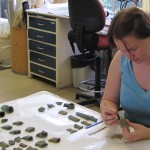
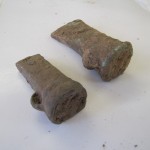
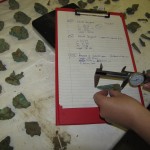
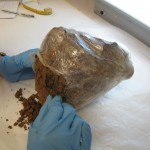
As well as working on the metal work, the block lifted vessel needed some attention. The pot was x-rayed in its block-lifted condition, and from this you can clearly see the outline of two socketed axes – one appeared to be complete, and the other showed the blade end only. The lower areas of the pot show up as bright white areas, which is due to the high density of metalwork contained in the lower part of the pot. The x-ray was also important to see the extent of damage to the pottery; you can clearly see there is no ceramic material present on one side and that a piece of metal work has been pushed outside the pot.
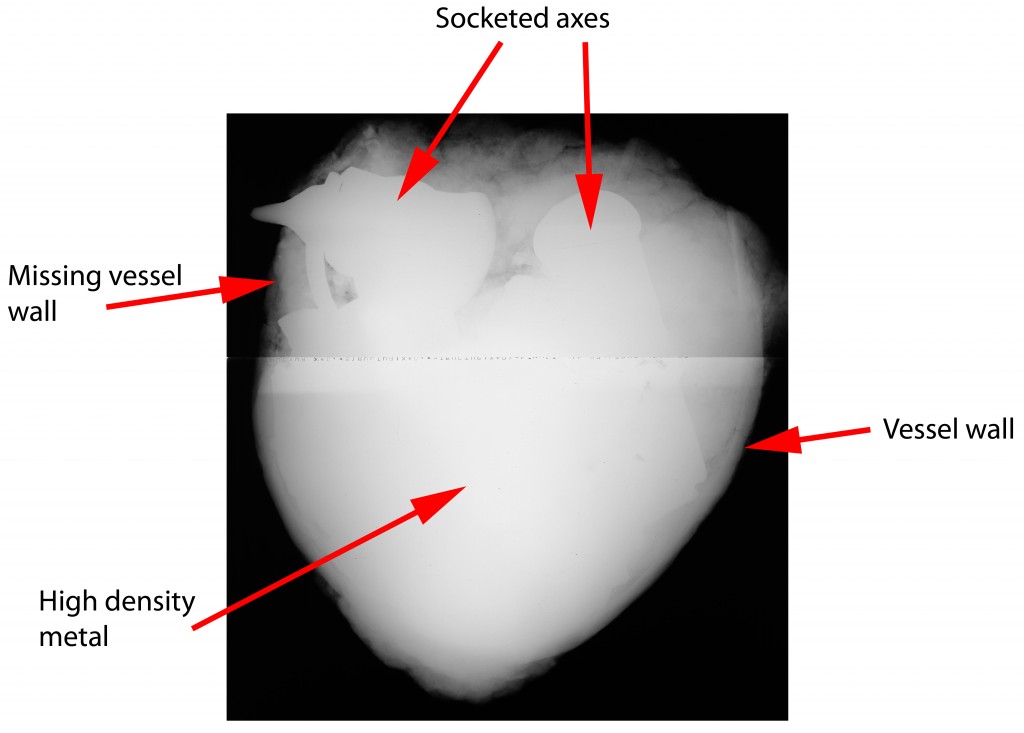
The pot was then unwrapped and examined by Stefanie White (Conservator, Colchester and Ipswich Museums) to assess the condition of the pottery vessel, particularly in the areas where we knew damage had already occurred. Looking at the base and walls of the vessel, there were some clear fractures that needed to be addressed before we could even consider excavating the contents.
Stefanie surface cleaned the outside of the pot, and consolidated the areas around the fractures with some reversible conservation adhesive. A support of bandages, calico and a polymer was then made and wrapped around the base and sides of the vessel. This helped to reinforce the pottery and keep it stable, enabling us to start removing the metal contents of the pot.
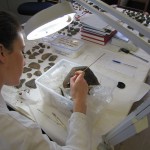
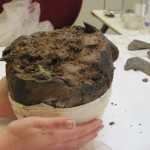
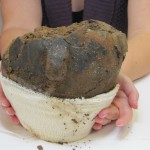
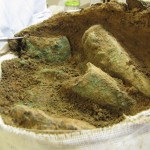
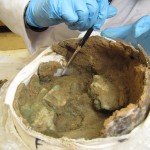
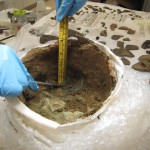
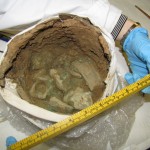
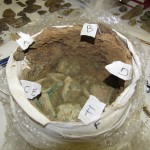
The soil was removed in layers using the x-ray as a guide, and the position of the metal work was documented. Two complete and some fragments of socketed axes were removed, as well as part of an ingot and the tip of a socketed spear. As with excavating the inside of the socketed axes, we were keeping an eye out for any potential organic inclusions in the hoard.
Further soil was removed, and an area completely compact with metal work was found – this is the area of ‘white’ from the x-ray. As the objects at this point were so tightly packed in the vessel, the surfaces of the metalwork had corroded together, making it impossible to remove any further pieces. A new approach to the conservation of the pot and the removal of its contents is now being considered.
11/04/2010
Since April, it’s been an interesting and enjoyable few months. I’ve assisted on four rallies (Foxham, Ludlow (x2) and the Fosse Way RABI one). There’s been a wide variety of finds to be recorded, which has been very nice. I’ve helped Angie out at some of her club meetings, so a big thank you to all of those club members for making me feel welcome.
I thought I would highlight a few of the more interesting finds I’ve dealt with over the last six months, to serve as a summary of my internship, and here they are:
An Upper Palaeolithic flint chopper from Shropshire.

Chopper
WAW-EC5E20
Palaeolithic
Shropshire
A Late Neolithic to Early Bronze Age discoidal scraper from Herefordshire.

Scraper (tool)
WAW-707AF4
Neolithic
Herefordshire
An almost complete Socketed Axe, of Bronze Age dating from Staffordshire.

Axe
WAW-F69CD5
Bronze age
Staffordshire
A bodysherd from a Middle Iron Age dated ceramic vessel, with scratch decoration, from Warwickshire.

Vessel
WAW-05C782
Iron age
Warwickshire
A copper alloy nummus of the House of Constantine, VRBS ROMA issue, with Wolf and twins on the reverse, dating from 330 to 335 AD. Discovered during the Fosse Way rally in Warwickshire.

Coin
WAW-960356
Roman
Warwickshire
A Wirral type Roman brooch, dating from 75 AD to 175 AD, found in Staffordshire.

Brooch
WAW-F49688
Roman
Staffordshire
A basesherd from a ceramic strainer type vessel, of Romano-British dating, from Warwickshire.

Vessel
WAW-28CA23
Roman
Warwickshire
A nice complete Cosmetic mortar, of Roman dating, from Derbyshire.

Cosmetic mortar
WAW-0B6B74
Roman
Derbyshire
The first Ansate type brooch recorded from Shropshire, dating from 8th to 9th Centuries AD.

Brooch
WAW-EF0D50
Early medieval
Shropshire
A sherd of pottery of Anglo-Saxon dating, from amongst the Romano-British pottery assemblage recovered by fieldwalking from the site at Tysoe, Warwickshire.

Vessel
WAW-4EA6D5
Early medieval
Warwickshire
A quarter of a Papal Bulla, issued by Pope Gregory IX (1227-1241), from Shropshire

Bulla
WAW-ECB526
Medieval
Shropshire
An almost intact Purse bar, of Late Medieval to Early Post Medieval dating, from Shropshire.

Purse
WAW-682D27
Medieval
Shropshire
An uncommon combination lock of mid 16th to 17th Century dating, from Shropshire.

Lock
WAW-04DD90
Post medieval
Shropshire
I will say, that although the internship has officially finished, this is not the last you will see of me. I am still planning on helping out my colleagues in the West Midlands team (Angie, Peter and Tom), either at club meetings, rallies or helping out with their back log of finds to be recorded.
Teresa
10/26/2010
This blog may end up being a bit rambly as it is meant to be bringing together an idea I have been thinking about since studying the Wirral brooches. If you read my blogs about the Wirral brooches you will have seen that the chequerboard pattern is one of the key features which defines the type. Whilst looking at the Wirral brooches I decided to look at other items recorded on the PAS database which had a similar pattern on to see if there were any links between them, perhaps they also clustered in the North West.
Some other Roman brooches are enamelled and some do have similar patterns, for example Wroxeter and the T-shaped brooches.
The object below is a Roman stud which has been enamelled with a chequerboard pattern in yellow and red. It appears to have been re-used/repaired at some point as there are are two small rivet holes. This may be due to the stud on the reverse breaking. However the important thing is the decoration.

The linch pin below is a really nice find on its own, in very good condition and with lovely decoration. However it also has the chequerboard pattern with the characteristic colours of red and yellow.
Wirral brooches
Below are two examples of the Wirral brooch. If you search for these items on the database then you will see c.35-40 of them, all with the chequerboard pattern, a lot with red, yellow and orange.


At the moment, from my limited work through my dissertation I am looking at ideas of continued style and art ideas from the Iron Age through to the Roman period, as this chequerboard pattern is common in both periods. I am hoping to investigate this trend more this year and will try to put more on the blog when I get time.






























